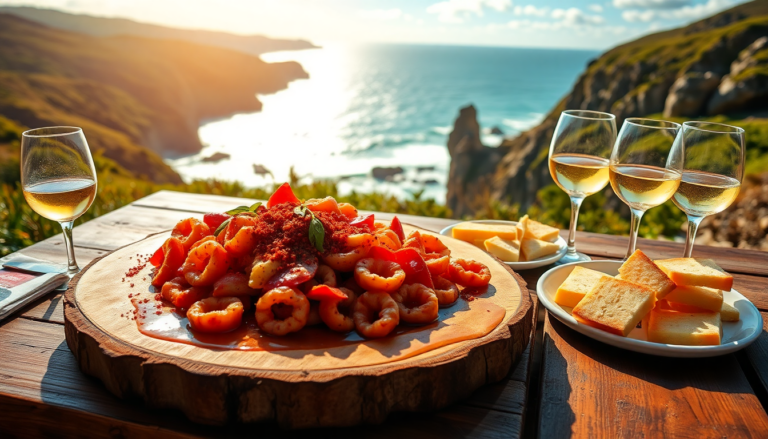Argomenti trattati
Galicia, tucked away in the northwest corner of Spain, is a sensory feast waiting to be discovered. With its rugged Atlantic coastline, lush valleys, and charming stone villages, it’s a place that leaves an indelible mark on your memory long after you’ve departed. Picture the briny scent of the sea blending seamlessly with the earthy fragrances of its verdant landscapes. Here, time seems to slow down, inviting you to not only soak in the stunning vistas but also to indulge in the exquisite flavors that characterize its vibrant culinary scene. If you’re on the hunt for unspoiled nature, mouthwatering dishes, and rich traditions, Galicia is a hidden gem just waiting to be explored.
The beaches of Galicia hold a special charm that rivals any you’ll find in Spain. This region is blessed with an extensive coastline dotted with secluded coves, sandy inlets, and dramatic cliffs that plunge into the Atlantic. The waters here may be cooler and more tempestuous than those of the Mediterranean, but this wild beauty offers a rare sense of peace and solitude. As I stroll along the shore, I always encourage visitors to seek out both the popular spots and the hidden treasures that reveal the true essence of this remarkable area.
If you have the luxury of time, be sure to explore Galicia’s lesser-known “rias” — estuaries that cradle unique ecosystems formed by the mingling of salt and freshwater. The Ría de Muros e Noia, for instance, showcases a delightful blend of fishing heritage and serene beaches, where local fishermen cast their nets against a backdrop of breathtaking natural beauty. These hidden gems not only enrich your journey but also provide a glimpse into the daily lives of the Galicians, making each visit feel wonderfully personal.
The Climate: An Invitation to Explore Throughout the Year
When it comes to planning your trip to Galicia, timing can significantly enhance your experience. The region enjoys a temperate oceanic climate, a refreshing contrast to the sweltering heat of southern Spain. The warmest months, from July to early September, invite sun-soaked beach outings and vibrant local festivals celebrating the region’s rich culture.
For those in search of tranquility, June and September offer delightful weather with fewer crowds and more affordable accommodation options. Spring and autumn are particularly captivating, with lush greenery blanketing the landscape, creating perfect conditions for hiking and breathing in the invigorating Atlantic air. While winter can bring its share of rain, cities like Santiago de Compostela pulse with life year-round. There’s something uniquely comforting about retreating to a cozy café and savoring a “café con leche” while raindrops dance against the window.
It’s worth noting that Galicia isn’t a sun-drenched paradise like Andalucía. The weather here shares similarities with coastal Brittany or Ireland, presenting a tapestry of changeable days. This unpredictability leads to a landscape bursting with flora—wildflowers and chestnut trees thrive in the moist air. Even in summer, I recommend packing layers, as evenings in August can bring a refreshing chill.
A Culinary Paradise: The Flavors of Galicia
For food lovers, Galicia is nothing short of a paradise. This region is famous for its incredible seafood, featuring freshly caught octopus, tender clams, and perfectly grilled sardines. Even the simplest bars serve dishes that highlight the freshness of their ingredients. Typically, these family-run establishments exude a charming, unpretentious atmosphere, encouraging diners to savor their meals rather than rush through them.
A visit to one of Galicia’s bustling food markets, such as Santiago’s Mercado de Abastos or Vigo’s O Progreso, is a must. These vibrant indoor markets overflow with local cheeses, cured meats, and baked goods, all fresh from local producers. I often find myself captivated by unexpected delights—a spicy chorizo or an almond-infused pastry that dances in my thoughts long after I’ve left. Engaging with vendors often unveils invaluable tips on the region’s hidden culinary treasures.
My journeys through Galicia have taught me a few invaluable lessons, and here are some insights I wish more travelers were aware of:
Is Galicia expensive? To my delight, I’ve found Galicia to be far more wallet-friendly than the bustling cities or the Costa del Sol. Dining is reasonably priced, even at establishments near the ocean, while charming country manors and boutique guesthouses offer excellent value, especially during the off-peak months.
What food is essential to try? Octopus “á feira” tops my list, alongside Galician empanadas, steamed mussels, and creamy Tetilla cheese. For dessert, don’t miss tarta de Santiago, an almond cake that pairs wonderfully with a robust coffee. And be sure to indulge in “filloas,” delicate crepes often served with local honey or cream.
Do people speak English in Galicia? While you might encounter some English speakers in tourist hotspots like Santiago de Compostela, rural areas tend to be less accommodating. I’ve navigated these situations with a mix of basic Spanish, gestures, and warm smiles. Bringing along a phrasebook or learning a few key phrases can significantly enhance your interactions with the friendly locals.
Are the beaches family-friendly? Absolutely! Many beaches, particularly those around Sanxenxo, O Grove, and A Coruña, are well-suited for families, complete with lifeguards during the summer months. The Cíes Islands also boast safe beaches, although services are limited, so I recommend packing snacks and plenty of water.
Year after year, I find myself drawn back to Galicia for its untamed beauty, relaxed lifestyle, and the warm spirit of its festivals. Whether you’re hiking along verdant cliffs, savoring freshly caught seafood, or meandering through quiet villages, Galicia offers an experience that lingers long after you leave. Each visit uncovers new corners of this enchanting region, transforming it from just a destination into an invitation to immerse yourself in a world of unforgettable experiences.

